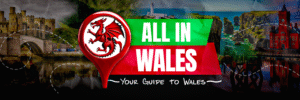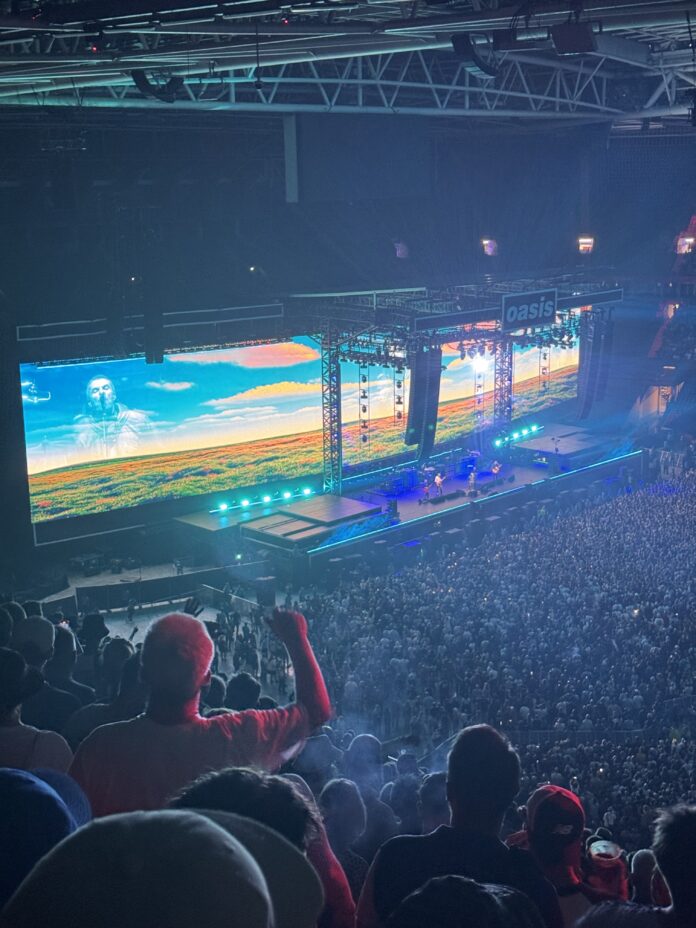When the Gallagher Brothers Chose Wales to Relaunch Oasis in the Most Anticipated Reunion in Music History
On a warm summer evening, July 4th, 2025, something extraordinary happened in the heart of Wales. The impossible became possible. After 16 years of bitter feuds, venomous public spats, and countless dashed hopes, Oasis, the Britpop legends who soundtracked a generation and defined an era, finally reunited for the opening night of their Live ’25 world tour at Cardiff’s iconic Principality Stadium. The show marked the band’s first live appearance since their acrimonious and very public split in 2009, and for one unforgettable weekend, Cardiff transformed into the epicenter of the rock and roll universe, with fans traveling from every corner of the globe to witness history in the making.
The Rise of a Generation’s Soundtrack
To truly understand the magnitude of this momentous occasion, we need to rewind the clock to the gritty streets of Manchester in 1991. Oasis was formed by the charismatic and often volatile Liam Gallagher, along with Paul “Bonehead” Arthurs, Paul McGuigan, and Tony McCarroll. The band played the usual circuit of dingy pubs and small venues, but everything changed when Liam’s older brother Noel, already an experienced songwriter and guitarist, joined the lineup. The chemistry was immediate, explosive, and undeniable.
Within just a few short years, Oasis became one of the biggest cultural phenomena of the entire era. Their debut album ‘Definitely Maybe’ crashed into the charts in 1994, becoming the fastest selling debut album in British history. It was raw, confident, and unapologetically working class, capturing the spirit of a generation that felt overlooked and underrepresented. Songs like “Live Forever,” “Slide Away,” and “Rock ‘n’ Roll Star” weren’t just tracks on an album; they were anthems of aspiration and defiance.
The success was staggering and unprecedented. All seven of their studio albums shot straight to number one on the UK charts. They racked up eight number one singles, from ‘Some Might Say’ to ‘The Importance of Being Idle’, plus another fifteen Top 10 hits that dominated radio airwaves throughout the 1990s and 2000s. But the crowning achievement came in 1996 when Oasis performed two legendary concerts at Knebworth House. Over those two balmy August nights, they played to 125,000 people each evening, with an estimated 2.6 million people having applied for tickets. It was a defining moment not just for the band, but for British music history itself.
Their second album, ‘(What’s The Story) Morning Glory?’, released in 1995, became one of the best selling albums of all time in the UK, spawning mega hits like “Wonderwall,” “Don’t Look Back in Anger,” and “Champagne Supernova.” These weren’t just songs; they became woven into the fabric of British culture, played at weddings, funerals, football matches, and every significant moment in between.
But behind the swagger, the success, and the stadium filling shows lay a deeply troubled and volatile relationship between the Gallagher brothers. Their arguments were legendary, their fights physical, and their mutual contempt barely concealed. The tension had been building for years, simmering beneath the surface of every album, every tour, every interview.
In 2009, that tension finally reached its breaking point. Backstage at the Rock en Seine festival in Paris, just minutes before they were due to take the stage, the brothers had a vicious confrontation. Liam lunged at Noel with a guitar in hand, and that was it. Noel walked out, not just from the venue, but from the band entirely. “It’s with some sadness and great relief to tell you that I quit Oasis tonight,” Noel stated in a message posted online. “I simply could not go on working with Liam a day longer.” The band that had seemed invincible was dead.
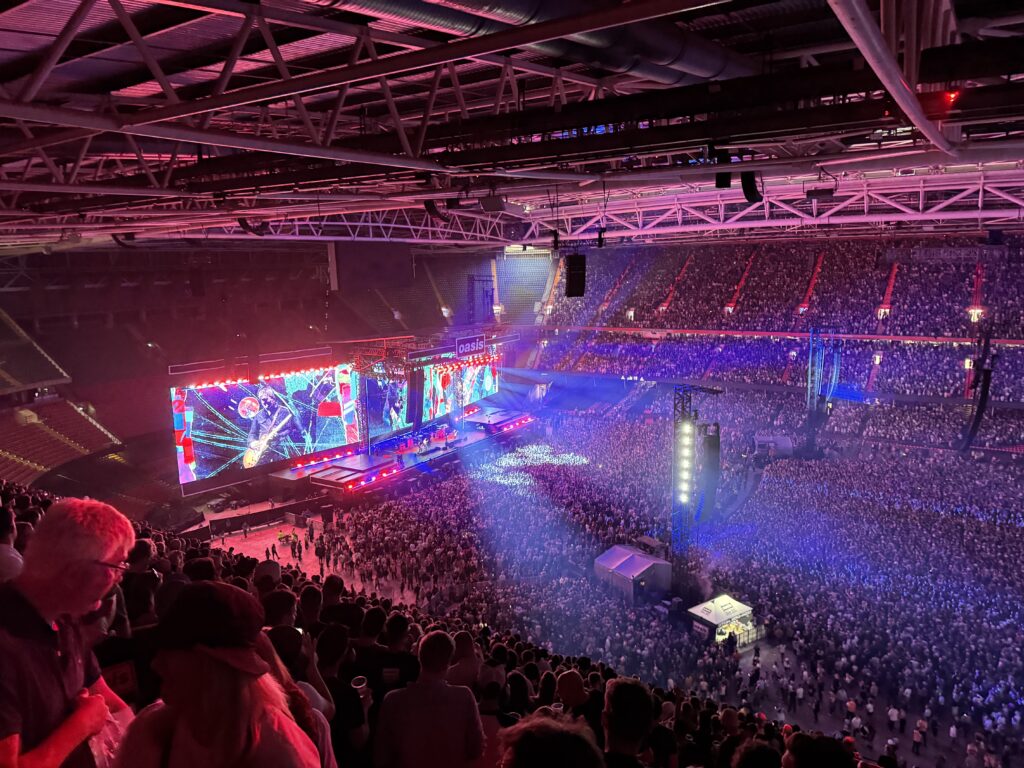
Sixteen Years in the Wilderness
For years after the split, a reunion seemed not just unlikely, but genuinely impossible. The brothers pursued successful solo careers while continuing to trade increasingly bitter barbs in the press and on social media. The insults were creative, cruel, and constant. In 2011, Liam told LA Weekly in characteristically blunt fashion: “I’d rather eat my own shit than be in a band with him again.” Noel, for his part, seemed equally resolute, repeatedly shutting down any suggestion of reconciliation.
Liam formed Beady Eye with former Oasis members Gem Archer, Andy Bell, and Chris Sharrock, releasing two albums before the project dissolved. He then launched a solo career that proved remarkably successful, with his debut album ‘As You Were’ going straight to number one. Noel created Noel Gallagher’s High Flying Birds, releasing a string of critically acclaimed albums and headlining major festivals worldwide.
Both brothers were doing well, but something was missing. Fans never stopped asking, never stopped hoping. At every solo show, the Oasis songs were the ones that got the biggest reactions, the loudest singalongs, the most emotional responses. The songs belonged to something bigger than either brother individually.
As the years passed, something imperceptible began to shift. Liam’s public comments about his brother became slightly less hostile, occasionally even affectionate. He began reserving a seat for Noel at his solo shows, a gesture that seemed simultaneously hopeful and heartbreaking. Social media posts became more cryptic, more suggestive. Fans began to wonder: could it actually happen?
Then, on August 27, 2024, two days before the 30th anniversary of the release of ‘Definitely Maybe’, the impossible was announced. Oasis were reuniting. The statement was simple: “The stars have aligned. The great wait is over.” The internet exploded. Social media crashed. Grown men and women wept. The announcement sent shockwaves through not just the music world, but popular culture itself.
The impact was immediate and measurable. Six of Oasis’s releases immediately re-entered the UK charts, with “Live Forever” reaching a new peak position of number eight, higher than it had ever charted during the band’s original run. The song’s title suddenly seemed prophetic.
Why Cardiff? The Perfect Choice for a Historic Return
When the initial tour dates were revealed, one detail surprised many observers: Cardiff would host the opening shows, not Manchester or London. Why would the quintessentially Manchester band choose Wales for such a monumentally significant moment?
The answer came in the most Liam Gallagher way possible. A mural painted on the side of Cardiff’s Utilita Arena featured one of Liam’s characteristically direct tweets: “Because Cardiff is the bollocks.” It was funny, affectionate, and absolutely sincere.
But beyond Liam’s seal of approval, there were sound practical and strategic reasons for the choice. The Principality Stadium, formerly known as the Millennium Stadium, offered everything the band needed for their grand return. With a capacity of 62,000 fans, it was large enough to feel epic but not so overwhelming as Wembley’s 90,000 capacity. The venue’s retractable roof meant the show would proceed flawlessly regardless of the notoriously unpredictable Welsh weather, ensuring nothing could derail this historic moment.
Perhaps most importantly, Cardiff offered something London and Manchester couldn’t: a chance to ease back into being Oasis away from the most intense media scrutiny. In Manchester, the pressure would have been suffocating, every moment dissected by hometown fans who’d watched the brothers grow up. In London, the media circus would have been overwhelming. Cardiff provided the perfect balance: a major city with excellent infrastructure, a passionate music loving crowd, and just enough remove to let the brothers find their footing again.
It was also a city that had always embraced Oasis. Wales has a proud musical heritage and Cardiff has long been a vital stop on the UK touring circuit, with crowds known for their enthusiasm and appreciation for rock music. The city deserved this moment, and Oasis knew it.
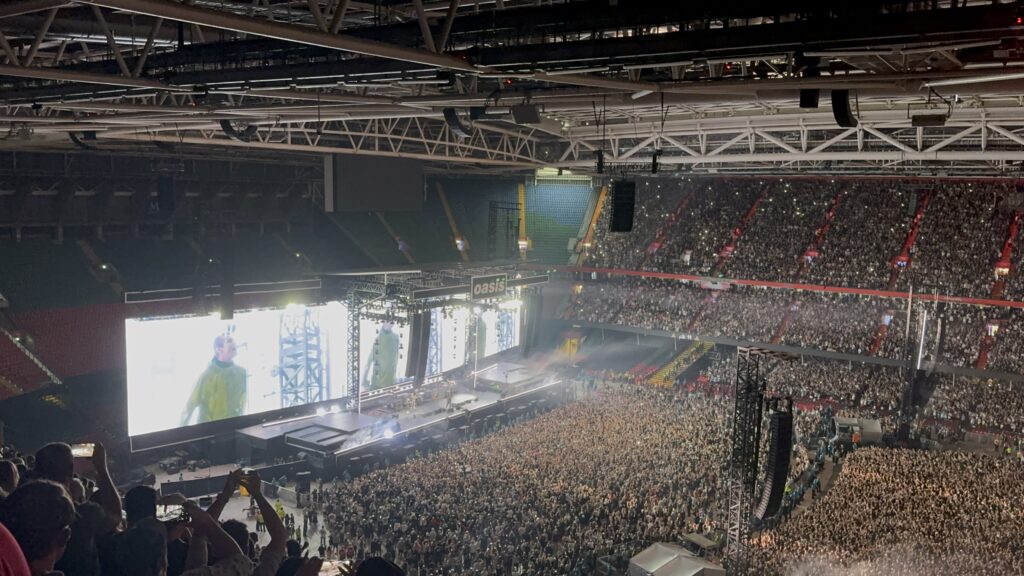
Cardiff Transformed: The Weekend the City Became Oasis Central
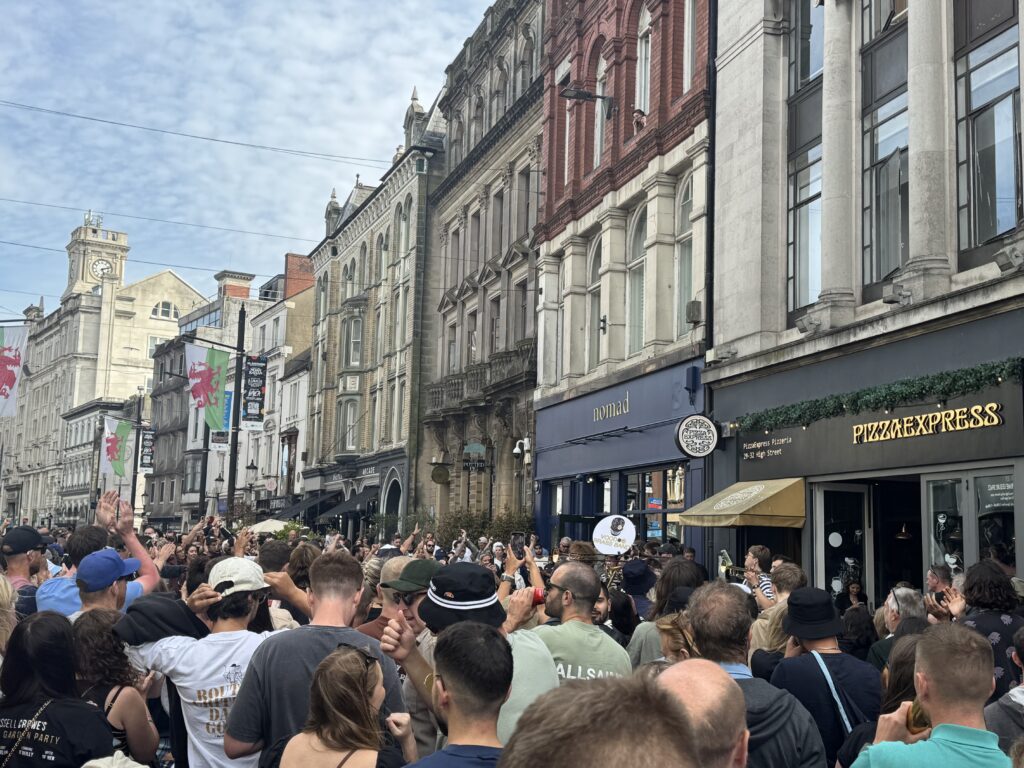
In the days and weeks leading up to the shows, Cardiff underwent a remarkable transformation. The entire city became consumed with Oasis mania in a way that recalled the height of Beatlemania or the cultural impact of Taylor Swift’s Eras Tour. This wasn’t just a concert; it was a pilgrimage, a celebration, a moment of collective cultural significance.
The atmosphere in Cardiff was electric and celebratory. A marching band paraded down the high street, their brass instruments blaring out a rousing version of “Roll With It” while delighted shoppers stopped to watch and sing along. The BBC set up broadcasts across the city, capturing the building excitement and interviewing fans who had traveled from Japan, Australia, Argentina, and every corner of Europe.
Local businesses got creative with their Oasis tributes. Convenience stores printed life size cardboard cutouts of Liam Gallagher, though hilariously, some chose less than iconic photos, with one cutout making Liam look like he was putting his bins out for collection rather than fronting the world’s greatest rock band. Pubs created special Oasis themed cocktails with names like “Cigarettes & Alcohol” and “Morning Glory.” Street vendors sold unofficial merchandise alongside the official tour gear.
At Clwb Ifor Bach, one of Cardiff’s most beloved independent music venues, pre parties raged through the night. Groups of fans, many wearing the band’s signature bucket hats and parkas despite the summer heat, unfurled personalized flags featuring the Oasis logo, images of the brothers, and lists of the shows they’d be attending: Cardiff, Manchester, London, Dublin. Some had traveled to multiple countries just to secure tickets through various presales. Their dedication was absolute.
An official Oasis merchandise popup shop opened in Millennium Plaza near the stadium, with fans queuing for hours to get their hands on the new tour merchandise, particularly the stylish collaboration with Adidas that included bespoke football shirts, one in sky blue as a nod to the brothers’ beloved Manchester City Football Club.
The ticketless gathered outside the stadium, content just to hear whatever sound leaked out through the walls, to be close to history in whatever way they could. The entire city had become a celebration of not just a band, but of resilience, reconciliation, and the enduring power of great music.
The Historic First Show: Rock and Roll Redemption
As the sun began to set on July 4th, 2025, 62,000 fans packed into the Principality Stadium, filling every seat, every standing area, every possible space. The retractable roof was closed, creating an intimate arena atmosphere despite the massive scale. The anticipation was almost unbearable, the air thick with emotion and disbelief.
The support acts set the tone perfectly. Cast, fellow Britpop survivors with their own string of 90s hits, warmed up the crowd with classics like “Walk Away” and “Fine Time.” Then came Richard Ashcroft, the legendary frontman of The Verve, delivering an emotional set that included “Sonnet” and “Bitter Sweet Symphony,” reminding everyone of that golden era of British rock.
At exactly 8:15 p.m., the stadium lights dropped to darkness. The screens blazed to life with a montage of newspaper headlines and social media posts: “OASIS TO REUNITE?” “THE IMPOSSIBLE MADE POSSIBLE.” “THE STARS HAVE ALIGNED.” Then came the message that brought roars from the crowd: “THIS IS NOT A DRILL.”
The opening riff of “Fuckin’ in the Bushes” exploded through the sound system, the aggressive, confrontational instrumental that had been Oasis’s walk on music throughout the 2000s. It felt like a declaration of intent, a middle finger to anyone who’d doubted this moment would come. The screens showed archive footage from the Isle of Wight Festival with its famous quote: “We put this festival on with a lot of love. And you wanna break our walls down?”
Then they appeared. Liam and Noel Gallagher walked onto the stage arm in arm, a sight that seemed impossible just a year earlier. They pumped their fists to the crowd, smiled genuine smiles, and took their positions. Liam grabbed the microphone with his trademark swagger, standing in that iconic hands behind his back pose. Noel strapped on his guitar. The rest of the band took their places: Gem Archer on rhythm and lead guitar, Andy Bell on bass, the returning Paul “Bonehead” Arthurs on rhythm guitar (his first Oasis show since 1998), and Joey Waronker on drums, alongside touring members Christian Madden on keyboards, Jessica Greenfield on backing vocals, and a three piece horn section.
A Setlist for the Ages: Every Song a Monument
The opening notes of “Hello” rang out, and the entire stadium erupted. This wasn’t just any opener; “Hello” hadn’t been performed live since 2002, making it a deep cut for longtime fans and a statement of intent. The song, from their 1995 album ‘(What’s The Story) Morning Glory?’, features Liam’s snarling vocals on lyrics that now felt loaded with meta significance: “I don’t feel as if I know you / You take up all my time.” Was this the brothers singing to each other? To their past? To the audience? It didn’t matter. It was perfect.
Then came “Acquiesce,” and this was the moment everything became real. Originally released as a B side to their first UK number one single “Some Might Say,” “Acquiesce” is unique in the Oasis catalog for featuring both brothers sharing lead vocals, with Liam taking the verses and Noel soaring on the choruses. The lyrics, written by Noel, take on new meaning in the context of the reunion: “We need each other, we believe in one another.” As their voices intertwined for the first time in 16 years, grown men in the audience openly wept. This was the sound of reconciliation, of brotherhood restored, even if just for these precious moments.
“Morning Glory” followed, the title track from their landmark 1995 album. Noel has described this song as his “cynical” take on the cocaine fueled excess of the 1990s music scene, with its memorable chorus about “taking that ride to nowhere.” But in 2025, freed from the chaos of their youth, the song felt like a celebration of survival, of making it through to the other side.
“Some Might Say” had the entire stadium bouncing, 62,000 people moving as one. The song, their first UK number one, is pure Britpop perfection with its optimistic message that “some might say that sunshine follows thunder.” After 16 years of thunder, the sunshine had finally arrived.
“Bring It On Down” from ‘Definitely Maybe’ brought the aggression and raw energy of early Oasis, reminding everyone that these were working class kids from Manchester who’d conquered the world through sheer force of will and undeniable talent. The song hadn’t been performed since 2006, making it another special rarity.
“Cigarettes & Alcohol” sparked mass singalongs, its two chord riff borrowed from T. Rex’s “Get It On” but transformed into a defiant working class anthem. The song’s message about wanting “a house in the country” but only being able to afford cigarettes and alcohol resonated just as powerfully in 2025’s economic climate as it did in 1994.
“Fade Away” was particularly emotional. Liam dedicated the B side to Burnage, their childhood neighborhood in Manchester, asking if anyone in the crowd was from there. His vocals were superb, and it marked the first time he’d sung the song live since 2002. The lyrics about not wanting to “fade away” felt especially poignant given the band’s near mythical return.
“Supersonic,” their debut single, had the crowd absolutely bouncing. This was the song that started everything, that announced Oasis to the world in 1994 with its swaggering confidence and memorable opening line about needing to be oneself. The energy was relentless.
“Roll With It” sparked waves of movement through the crowd, everyone swaying together. The song, from ‘(What’s The Story) Morning Glory?’, became an anthem during the mid 90s peak of Britpop rivalry with Blur.
Then the tempo shifted beautifully. “Talk Tonight” brought intimacy to the massive stadium setting. Noel took over lead vocals for this tender acoustic ballad, which he wrote during a difficult period on tour in San Francisco in 1994. The story goes that Noel had walked out on the band after a disastrous show, spending the night drinking with a fan who talked him through his frustrations. The song is about that conversation, about finding solace in unexpected places, and hearing Noel sing it in Cardiff felt like an acknowledgment of how far they’d all come.
“Half the World Away,” another Noel vocal turn, is beloved by British audiences as the theme song to the sitcom “The Royle Family,” but it’s also simply a gorgeous piece of songwriting about distance and longing. In the context of the brothers’ reunion, every line carried extra weight.
“Little by Little” continued Noel’s vocal segment, the song not having been performed since 2005. Its chorus, “we all gotta face it, we’re all gonna face it someday,” felt appropriate for a band and two brothers who had finally faced their demons and found a way forward.
When Liam returned to vocal duties for “D’You Know What I Mean?”, the energy exploded again. The song, the lead single from their 1997 album ‘Be Here Now’, is Oasis at their most epic and bombastic, and it was performed in a shortened version that still packed massive impact. It hadn’t been played in full since 2002.
“Stand by Me” brought everyone together, the entire stadium singing the chorus back to Liam. The song hadn’t been performed since 2001, making it another special resurrection for this tour.
“Cast No Shadow,” a beautiful, melancholic song written by Noel about Richard Ashcroft (who’d performed earlier that evening), hadn’t been played since 2002. Its lyrics about a man who “found a way to get along” resonated deeply with the crowd.
“Slide Away” was absolutely breathtaking. One of Oasis’s most emotional songs, it’s a devastating ballad about the end of a relationship that Noel wrote about his then girlfriend. The song would later be released as an official live recording from this Cardiff show, capturing its raw emotional power. The stadium became a choir, tens of thousands of voices singing together.
“Whatever” was a surprise highlight, featuring Liam on vocals for the first time since 1996. The orchestral B side is one of their most ambitious arrangements, and hearing Liam tackle it nearly three decades after last performing it was genuinely moving.
“Live Forever” had extra significance as Noel dedicated it to Liverpool footballer Diogo Jota, who had tragically died in a car accident just days earlier at only 28 years old. When Jota’s image appeared on the screens during the song, the crowd erupted in applause and emotion. The song’s message about living forever through love and legacy felt especially powerful in that moment.
“Rock ‘n’ Roll Star,” the opening track from ‘Definitely Maybe’, closed the main set with its defiant declaration: “I live my life in the city / There’s no easy way out.” For two kids from Burnage who became the biggest band in Britain, it was a reminder of where they’d come from and what they’d achieved.
The Encore: Bringing It All Home
After band introductions, they returned for an encore that was simply perfection.
“The Masterplan” opened the encore, with Noel dedicating it to “all the people who are 20 and have never seen us before.” It was a touching acknowledgment that a new generation had discovered Oasis through their parents, through streaming services, through TikTok and YouTube. This wasn’t just about nostalgia; it was about passing the torch.
“Don’t Look Back in Anger” created one of the most spine tingling moments of the entire evening. This was the first time the song had been performed with a full band since 2007, and it’s become one of Britain’s most culturally significant songs, sung at vigils, protests, and moments of national unity. When 62,000 people sang “So Sally can wait” together, it transcended being just a concert moment. It was communal, spiritual, healing.
“Wonderwall” needs no introduction. It’s one of the most recognizable songs ever written, a global phenomenon that’s been covered thousands of times and streamed billions of times. Everyone knows every word, and everyone sang them.
They closed with “Champagne Supernova,” the eight minute epic from ‘(What’s The Story) Morning Glory?’ that asks the eternal question: “Where were you while we were getting high?” As confetti cannons exploded and the song built to its triumphant climax, there wasn’t a person in the stadium not overcome with emotion.
A Show for the Ages
The reviews were ecstatic. NME gave the show five stars, writing: “After a 90s heyday and an often maligned post millennium era, this is Oasis redesigned for the 21st Century. Playing before a pop art meets psychedelia visual spectacular that never distracts but will look sick on a phone, they seem the quintessential stadium band playing the greatest hits of greatest hits.”
What struck many observers was the mix of generations in the audience. This wasn’t just middle aged Britpop survivors reliving their youth. A substantial portion of the crowd was Gen Z, fans in their late teens and early twenties who’d discovered Oasis through their parents’ CD collections, through FIFA soundtracks, through streaming algorithms. For them, this wasn’t nostalgia; it was a first experience, and the intergenerational nature of the audience proved that great songs are genuinely timeless.
The production was state of the art, with stunning visuals that ranged from psychedelic animations to archival footage to simple, powerful imagery that never overwhelmed the music. The sound, enhanced by the closed roof of the Principality Stadium, was absolutely massive. Modern sound technology had evolved dramatically since 2009, and Oasis in 2025 sounded bigger, clearer, and more powerful than ever before.
The Controversy and the Chaos
Of course, no Oasis reunion would be complete without controversy. The ticket sale process had been chaotic and anger inducing. When general sale tickets went on sale on August 31, 2024, the entire UK internet essentially broke. Fans reported queue times of eight hours or more, 503 error messages, being mistakenly flagged as bots, and worst of all, dynamic pricing that saw ticket prices surge to over £350 for standing tickets that were initially advertised at £150.
Two nosebleed seats for a London show were reportedly listed on resale site Viagogo for over £23,000 each. The controversy was so severe that UK Prime Minister Keir Starmer’s government launched investigations, and the Competition and Markets Authority eventually concluded that Ticketmaster “may have misled Oasis fans” with unclear pricing. In late October 2024, promoters cancelled over 50,000 tickets and put them back on sale at face value.
But for those who made it through the gauntlet and secured tickets, none of that mattered now. They were witnessing history.
The Tour Continues: A Global Phenomenon
The Cardiff shows were just the beginning of what would become one of the most significant tours in rock history. The Live ’25 tour includes 41 dates spanning the United Kingdom, Ireland, North America, Asia, Australia, and South America, with the final show scheduled for November 23rd at Estádio do Morumbi in São Paulo, Brazil.
After Cardiff came five homecoming shows at Manchester’s Heaton Park, each one a massive outdoor celebration. Then seven nights at London’s Wembley Stadium, cementing the reunion as not just a nostalgic moment but a genuine cultural phenomenon. Shows in Edinburgh and Dublin followed before the band took their reunion global.
The North American leg kicked off in Toronto in August, with stops in Chicago, East Rutherford, Los Angeles, and Mexico City. Asian dates in South Korea and Japan were announced, followed by South American shows in Buenos Aires, Santiago, and São Paulo. Both Brazilian dates sold out all 132,000 tickets in under 60 minutes.
Planning Your Oasis Pilgrimage to Cardiff
While the historic July 2025 dates have passed, Cardiff remains a pilgrimage site for Oasis fans from around the world. The Principality Stadium, standing proud in the heart of the city, is a monument to that unforgettable weekend when the impossible happened.
Click Here for an overview on the Principality Stadium: Why the Principality Stadium is the Best Stadium in the World
Cardiff itself is a wonderful city to explore. Compact and walkable, it offers a perfect blend of Welsh culture, stunning Victorian and Edwardian architecture, modern amenities, and genuine hospitality. Cardiff Castle, a magnificent structure dating back to Roman times, sits right in the city center. The National Museum features impressive art collections and provides fascinating insight into Welsh history and culture.
Cardiff Bay, once a bustling dockland and now a revitalized waterfront district, offers excellent restaurants, the Wales Millennium Centre for arts and culture, and beautiful walks along the water. The Doctor Who Experience celebrates Wales’s connection to the beloved sci fi series, which films extensively in and around Cardiff.
For music lovers, the city’s venues remain vital stops on the UK touring circuit. Clwb Ifor Bach, the independent venue that hosted Oasis pre parties, continues to showcase emerging and established acts in an intimate setting. The Tramshed, a converted Edwardian transport depot, offers excellent acoustics and a capacity of around 1,000. And of course, the Principality Stadium continues to host the biggest names in music alongside its rugby and football duties.
The Welsh people’s warmth and pride in their culture make Cardiff an exceptionally welcoming destination. And for Oasis fans, walking the same streets where history was made, perhaps stopping for a pint in one of the pubs where fans celebrated that miraculous weekend, creates a tangible connection to one of rock’s greatest stories.
The Meaning of It All
The Oasis reunion transcends simple nostalgia or commercial opportunism, though there’s certainly plenty of both involved. At its heart, it’s a story about family, about art, about the possibility of reconciliation even when it seems impossible.
Liam and Noel Gallagher spent 16 years barely speaking, publicly feuding, building successful separate careers, and seemingly content with their separation. Yet something drew them back together. Perhaps it was the approaching 30th anniversaries of their landmark albums. Perhaps it was financial opportunity. Perhaps, as they’ve suggested, it was simply that “the time was right.”
Whatever the reasons, their reunion offers something increasingly rare in our divided, polarized times: proof that bridges can be rebuilt, that wounds can heal, that people who seemed permanently estranged can find their way back to each other. It’s not a fairy tale; the brothers have made clear in subsequent interviews that they’re not suddenly best friends. But they’ve found a way to coexist, to create together again, to give fans around the world the experience they’ve dreamed of for nearly two decades.
The songs themselves remain as powerful as ever, perhaps more so with the passage of time and the wisdom that comes with it. When Noel writes about needing to be free, when Liam sings about living forever, when they harmonize on lines about needing each other, the words carry layers of meaning they couldn’t have had in 1994.
Oasis was always more than just a band. They represented aspiration and working class pride, showed that kids from council estates could conquer the world, and created anthems that spoke to universal human experiences of love, loss, hope, and defiance. Their music soundtracked weddings and funerals, celebrations and consolations, victories and defeats. The songs became woven into the fabric of British life in a way few artists ever achieve.
The Legacy Lives On
As the Live ’25 tour continues its journey around the world, each show adds another chapter to the Oasis story. The Cardiff opening nights will always hold special significance as the place where it all started again, where two brothers proved that sometimes, against all odds and expectations, reconciliation is possible.
The sight of Liam and Noel walking onto that Cardiff stage together, arm in arm, will remain one of the defining images of 21st century rock music. It represents hope, second chances, the enduring power of great songs, and the complex beauty of family relationships that survive despite everything.
For the 62,000 people lucky enough to be in the Principality Stadium on July 4th and 5th, 2025, it was a night they’ll remember for the rest of their lives. For the millions watching clips online, reading reviews, and soaking up every detail, it was proof that magic still exists in the world. And for Liam and Noel Gallagher, it was a chance to reclaim their legacy together, to show a new generation what Oasis was and is, and to create new memories alongside the old ones.
Because Cardiff really is the bollocks. And on one perfect summer weekend, it became the center of the rock and roll universe, the place where the stars aligned and the great wait finally ended. The place where Oasis, impossibly, beautifully, came home.
The music lives forever. And for two nights in Cardiff, so did the dream.
